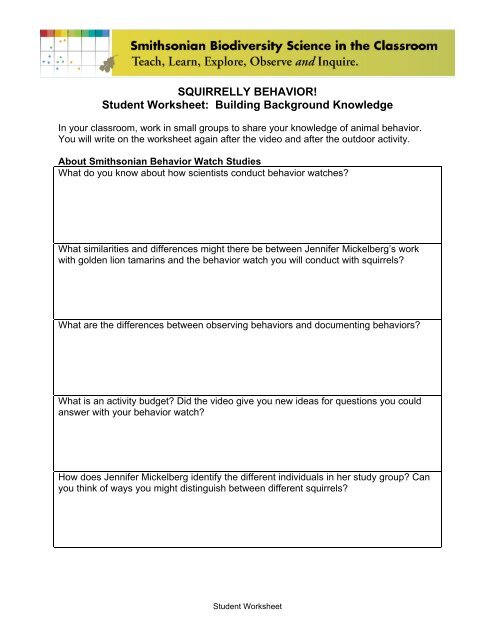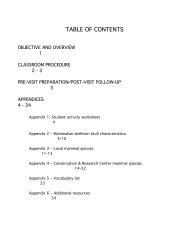SQUIRRELLY BEHAVIOR! Student Worksheet ... - National Zoo
SQUIRRELLY BEHAVIOR! Student Worksheet ... - National Zoo
SQUIRRELLY BEHAVIOR! Student Worksheet ... - National Zoo
Create successful ePaper yourself
Turn your PDF publications into a flip-book with our unique Google optimized e-Paper software.
<strong>SQUIRRELLY</strong> <strong>BEHAVIOR</strong>!<br />
<strong>Student</strong> <strong>Worksheet</strong>: Building Background Knowledge<br />
In your classroom, work in small groups to share your knowledge of animal behavior.<br />
You will write on the worksheet again after the video and after the outdoor activity.<br />
About Smithsonian Behavior Watch Studies<br />
What do you know about how scientists conduct behavior watches?<br />
What similarities and differences might there be between Jennifer Mickelberg’s work<br />
with golden lion tamarins and the behavior watch you will conduct with squirrels?<br />
What are the differences between observing behaviors and documenting behaviors?<br />
What is an activity budget? Did the video give you new ideas for questions you could<br />
answer with your behavior watch?<br />
How does Jennifer Mickelberg identify the different individuals in her study group? Can<br />
you think of ways you might distinguish between different squirrels?<br />
<strong>Student</strong> <strong>Worksheet</strong>
About Your Own Behavior Watch Study<br />
What question(s) about squirrels do we want to answer with your behavior watch?<br />
What behaviors should we expect to observe in squirrels?<br />
What behaviors would be best to watch for to answer our question(s)?<br />
Should we expect to see different behaviors (or different rates of occurrence of the<br />
behaviors) during different seasons of the year? . . . at different times of the day? Why<br />
or why not?<br />
<strong>Student</strong> <strong>Worksheet</strong>
Example of<br />
Behavior<br />
STUDENT HANDOUT: COMMON SQUIRREL <strong>BEHAVIOR</strong>S<br />
Definition<br />
Eating/drinking<br />
When an animal eats or drinks.<br />
Foraging<br />
When an animal is searching for food. The animal uses its nose<br />
or paws/hands to search for food.<br />
Grooming<br />
When an animal cleans itself by licking, scratching, or wiping its<br />
body.<br />
Resting<br />
When an animal is not changing location. This may include<br />
sleeping, sitting, and standing still.<br />
Social activity<br />
When an animal is interacting with another animal of the same<br />
species, such as playing, chasing, grooming, fighting, and<br />
breeding.<br />
<strong>Student</strong> Handout
SAMPLE CHECKSHEET<br />
STUDENT WORKSHEET: <strong>BEHAVIOR</strong> WATCH CHECKSHEET<br />
<strong>Student</strong> name(s): ___Jane and John________________________________ Date: ___April 1__________ Time started: __1:05 p.m._______<br />
Kind of animal: ___Gray squirrel___________________________________ Animal age: juvenile adult<br />
Other identification notes: ___Gray with a little brown on shoulders with a full tail_______________________________________________<br />
Location: ___School courtyard near feeder___________________ Temperature: ___65°F ____ Weather: sunny cloudy rainy<br />
Directions: Watch the same animal for 5 minutes. At the end of each 30 seconds, check the activity that you see the animal doing at that exact<br />
moment. You can have only one check mark per trial. You will end up with a total of 10 check marks.<br />
Trial time<br />
(minutes)<br />
Eating or<br />
Drinking<br />
Foraging Grooming Resting<br />
:30 <br />
1:00 <br />
1:30 <br />
2:00 <br />
2:30 <br />
Social<br />
Activity<br />
<strong>Student</strong> <strong>Worksheet</strong><br />
Not<br />
Visible<br />
Anything else<br />
3:00 Calling / barking an alarm<br />
3:30 <br />
4:00 <br />
4:30 <br />
5:00 <br />
Total = 3 3 0 1 1 1 1<br />
Percent = 30% 30% 0% 10% 10% 10% 10%
STUDENT WORKSHEET: <strong>BEHAVIOR</strong> WATCH CHECKSHEET<br />
<strong>Student</strong> name(s): _______________________________________________ Date: ________________ Time started: __________________<br />
Kind of animal: _________________________________________________ Animal age: juvenile adult (check one)<br />
Other identification notes: ________________________________________________________________________________________________<br />
Location: _______________________________________________ Temperature: ______________ Weather: sunny cloudy rainy<br />
Directions: Watch the same animal for 5 minutes. At the end of each 30 seconds, check the activity that you see the animal doing at that exact<br />
moment. You can have only one check mark per trial. You will end up with a total of 10 check marks.<br />
Trial time<br />
(minutes)<br />
:30<br />
1:00<br />
1:30<br />
2:00<br />
2:30<br />
3:00<br />
3:30<br />
4:00<br />
4:30<br />
5:00<br />
Total =<br />
Percent =<br />
Eating or<br />
Drinking<br />
Foraging Grooming Resting<br />
Social<br />
Activity<br />
<strong>Student</strong> <strong>Worksheet</strong><br />
Not<br />
Visible<br />
Anything else
Behavior Watch – Classroom Master Sheet<br />
<strong>Student</strong><br />
Names<br />
(Sample)<br />
Jane & John<br />
Time<br />
Slot<br />
Number<br />
of Trials<br />
Number of<br />
“Eating/Drinking”<br />
Number of<br />
“Foraging”<br />
Number of<br />
“Grooming”<br />
<strong>Student</strong> <strong>Worksheet</strong><br />
Number of<br />
“Resting”<br />
Number of<br />
“Social<br />
Activity”<br />
Number of<br />
“Not Visible”<br />
1:05 p.m. 10 3 3 0 1 1 1 1<br />
Total =<br />
Percent = 100%<br />
Number of<br />
“Anything<br />
Else”

















